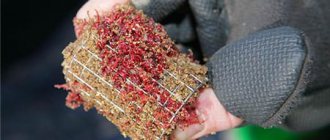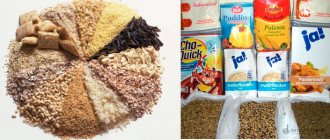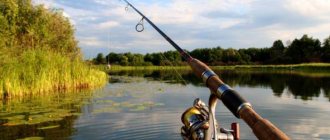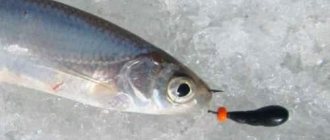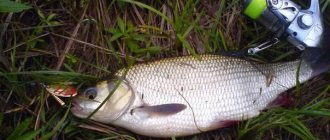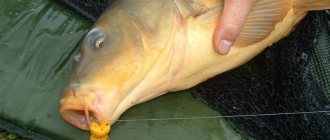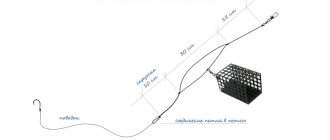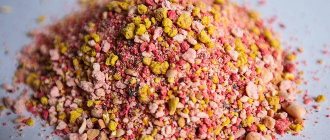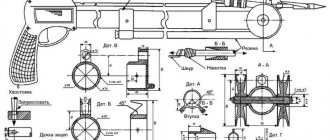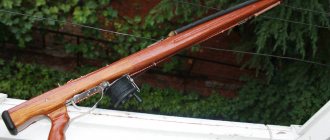Tench: description and behavioral characteristics
Tench is a member of the carp family.
A feature of this species is its sedentary lifestyle and heat-loving nature. The body is short, thick and moderately high. The scales of the representative are quite small in size and have a peculiarity: they are completely covered with thick mucus. Its shade is ambiguous, since there are representatives with a color from greenish-silver to dark brown with a slight bronze tint. The fins are small in size, and the tail does not have a pronounced notch. Eye color is red-orange. There are short mustaches at the corners of the mouth.
A special feature of the representative is its ability to “molt,” in other words, it changes the shade of its scales when jumping.
Regarding the behavior of such a fish, it can be noted that although it belongs to the carp family, unlike its relatives, it has a number of characteristic differences.
If you pay attention to the clumsy body of this species, you might think about its clumsiness, but only those fishermen who were not lucky enough to hold such a fish on a hook for even a moment can think so.
Some representatives reach a length of up to 70 cm and a body weight of up to 7 kg, so we can safely say that catching such fish is the dream of many fishermen.
Tench is a very careful and sensitive fish, so if the goal of fishing is to catch such an individual, then it is necessary to behave very quietly, and this applies not only to the manner of behavior on the shore, but also to the timbre of speech.
Breeding tench in a pond
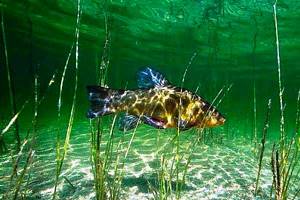
Tench is a fairly heat-loving bottom-dwelling fish. The habitat is very large. This fish is found in Siberia (up to the Yenisei), Asia Minor, the Caucasus, and almost all of Europe (except for the Scandinavian countries and the Kola Peninsula).
Tench has been known since ancient times, the ancient Romans used it back in the 4th century AD; there is a documented case (Masella's poem) when the Roman consul in Gaul, Decius Magnus Ausonius, glorified tinca, as the Romans called tench. Now tench is undeservedly forgotten.
Lifespan: 10 years; Puberty: 3-4 years; Spawning: May-August; Size: 20-35 cm, max 60 cm; Weight: 0.2-0.8 kg, max 3 kg
Tweet
Share
Plus
Share
Lin in Russia
Domestic fish farmers stubbornly avoid tench, although in Russia tench has also been known for quite a long time, because it lives along with crucian carp and carp in all ponds and reservoirs where fish lived. Lin has excellent taste characteristics, which made it very popular in its time. Tench meat is especially appreciated by gourmets. Fried tench was especially popular.
And in some cases, tench was used for medicinal purposes, for example, tench liver was used in the treatment of headaches and delirium tremens.
Appearance
Lin is easy to identify. His body is short, slightly compressed at the sides, very thick and quite tall. The caudal peduncle is very short, with a characteristic small notch.
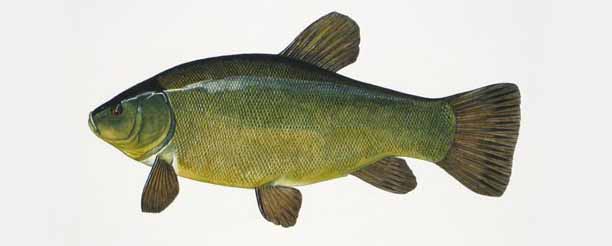
The fins are rounded, the back begins behind the vertical of the posterior edge of the base of the ventral fins, or almost above them. The pectoral fins are quite long. The tench's scales are extremely soft and fit very tightly to the body, making it very difficult to peel off. The tench's body is covered with a layer of mucus, which is especially noticeable at low water temperatures. The head of the tench is small, the snout is blunt, and the mouth is small. The tench has very short antennae along the edges of its mouth.
Small sizes reduce the importance of tench in the eyes of those fishermen who must boast of a large catch.
Tench is a sedentary fish and, as a rule, does not make large migrations. During spawning, each female releases up to 1 million eggs (per season), usually this happens in several stages. Spawning itself takes place from May to July, at a temperature of +20…+25 ⁰С. Usually in natural reservoirs it grows quite slowly (see table).
| Age in years | Body length in cm |
| +1 | 3-7 |
| +2 | 6-12 |
| +3 | 11-17 |
| +4 | 15-23 |
| +5 | 17-26 |
| +6 | 20-29 |
| +7 | 25-32 |
As mentioned above, tench meat has excellent taste; it is sweetish in taste and very juicy, although if it is not cooked correctly, it can taste slightly muddy. Meat of medium fat content (approximately 3.8%).
Unlike carp and other fish of this family, tench is a very unpretentious fish, rubella does not attack it, and thanks to the thick mucus covering the body, the vast majority of bacteria and parasites are also not able to harm it.
Since tench is an unpretentious fish, even reservoirs in which other fish cannot survive are suitable for growing tench. Tench can survive in bodies of water with low oxygen levels and completely overgrown with algae. It can survive in peaty reservoirs, where even carp, with all its unpretentiousness and vitality, is not able to survive for long.
Females mature approximately in the third or fourth year of life, males are faster, they are already able to fertilize eggs in the second or third year of life, in the northern regions this happens one to two years later. Tench becomes sexually mature at a body length of 17-18 cm and a weight of 120 grams. With such sizes, the fecundity of tench ranges from 20 to 40 thousand eggs. In large specimens weighing more than 800 grams, fertility is up to 500 thousand eggs. Typically, two to three males are required from one female to fertilize eggs. Producers are harvested in the spring at a water temperature of +10…+16 ⁰С. In tench, the female is easy to distinguish from the male. As a rule, males have thickened ventral fins, the first bony rays are especially distinguished; the fins themselves are longer than those of females.
Spawning
Spawning usually occurs in small bays and ponds up to 30-50 cm deep. Macrophytes with submerged leaves of pondweed, urut, etc. serve as a substrate for gluing eggs, but if there is nothing of the kind, spawning can also take place on artificial nests made of sponge , Old Delhi. This is usually secured to the hoop with threads. Spawning itself begins at a water temperature of +20 ⁰С and lasts for a month, while spawning continues even when the water temperature rises to +24...+25 ⁰С, spawning usually takes place in portions. After the first portion, the next spawning occurs after 6-10 days. After the same interval, two or three more clutches will occur.
In the western part of Europe, special pituitary injections are used to produce offspring. In Poland, larvae are prepared for export in this way. When harvesting larvae, spawners are kept in special ponds or flow-through trenches (usually this is done in the Czech Republic and Slovakia), spawners are planted at a density of 50 pcs/m3. Typically, working fertility is 100 thousand pieces. per 1 kg of female. Manufacturers are given injections at the rate of 10-20% (preliminary) of the volume of the carp suspension and after 12-24 hours a permissive injection - approximately 1-5 mg per 1 kg of average weight. Males are injected only once - approximately 3-5 mg per 1 kg of body weight. At a water temperature of +21...+24 ⁰С, the game matures within 22-26 hours after the permissive injection. If the water temperature drops below +20 ⁰C, ovulation of eggs may not occur.
Injected individuals can be left in the pond, but in this case the fish may get out of control and the eggs will be released, in which case the eggs will remain unfertilized. Typically, 100 ml of caviar requires about 0.3-0.5 ml of milt from two to three males. In order to de-stick caviar, talc and milk are used. Incubation of eggs is carried out in special Weiss apparatus. Usually 1 liter of caviar is laid, containing 0.7 million eggs. If you do not have a Weiss apparatus, then fertilized but not deglued eggs are placed for incubation on an artificial substrate placed in the pond. And for better incubation, it is better to place the substrate in an area of active water supply or water exchange. Under such conditions and at a temperature of +20 ⁰C, the incubation period is up to 75 hours, so that the larvae hatch on the third day, however, at higher temperatures, the development of embryos can be slightly faster (up to 70 hours).
Larval development
The hatched tench larvae are only 3.5-3.6 mm long. They attach to the substrate and feed on the reserves of the yolk sac for 3-4 days. During this time they grow to 4.5-4.7 mm. And they concentrate in shallow water, here they begin to feed on unicellular algae, as well as small zooplankton. If there are a lot of larvae, they are usually fed with small zooplankton filtered through gas. When the fry grow to 6.5 mm, larger organisms enter their diet, and the fry themselves spread throughout the pond. When they reach a size of 1.3 cm, the fry begin to feed on bottom organisms. The most suitable temperature range for the growth of fry is +20...+29 ⁰С; if the temperature drops to +10 ⁰С, the fish stops feeding, and at +4 ⁰С the tench is buried in silt and falls into a state close to suspended animation. When the tench reaches a size of 12 cm, it must be seated so that there is enough food for all individuals.
Raising fingerlings
In Russia, in ponds measuring 500 m2, one female weighing 0.9 kg and two males produce up to 10 thousand fingerlings with an average weight of 12 grams. In order for the fingerlings to be larger, their density is reduced to 56 thousand pcs./ha, and sometimes up to 600 pcs./ha; in this case, they are no longer fed and are not transplanted for wintering. At this density, the mass of fingerlings is 12 grams. may increase to 25-45 g. Fledglings feed on worms, small mollusks, and plant remains, but usually prefer detritus. If the density of the fish is such that there is not enough natural food, then it is necessary to feed it with artificial food. To do this, you need to install a feeder on the pond and regularly feed the fish with compound feed, grain waste, weed seeds, as well as fresh vegetables minced through a meat grinder (carrots, potatoes, beets), finely chopped cabbage, pondweed, etc. are excellent. When growing fry in a polyculture with silver carp in Germany, dry feed was more effective, with only 2.5 kg of feed required per 1 kg of weight gain.
When growing in a polyculture with carp, it is recommended to use overgrown and silted ponds; tench easily master such biotopes, this allows the natural food supply of the pond to be used as efficiently as possible.
Growing commercial fish
If first-year students have gained 25-45 grams. weight, then in the second year of life they can reach a marketable weight of 180-200 grams. Otherwise, growing tench lasts three years, in which case it reaches a weight of 380-400 grams. In the southern regions of Russia, tench can reach such a mass already in the second year of life, and in another year it can reach 800-900 grams.
When growing two- and three-year-olds in natural ponds, the recommended planting density can be increased by 5-10 times. In this case, feeding is the same as for fingerlings. It is best to feed commercial fish at feeding places with chopped vegetables, mixed feed, and grain waste.
Fish productivity can be up to 12 c/ha. In a polyculture with carp, marketable tench is 12 c/ha with a total productivity of 15 c/ha.
Two- and three-year-old tench, mastering overgrown shallow waters and silted areas, eat much less feed than their relatives carp, silver carp, and grass carp.
In recent years, special pools, trays and aquariums with a closed water exchange system have been used to grow tench.
Fishing ponds
In small bodies of water there is usually no problem with catching tench. It is usually concentrated in the area of feeding areas and is easily caught by dragnets. In large reservoirs, catching is somewhat more difficult; it is necessary to drain the water at night and without noise, otherwise the tench will bury itself in the silt and remain there, even if all the water leaves the pond. Concentration of tench on the bed: for this you will need a reclamation network and a recessed area, the so-called. fish collection pit in front of the “Monk” assembly device.
Transportation
Tench is one of the most convenient fish for transportation over long distances. This requires a humid atmosphere; with sufficient humidity, tench can live without water for up to 56 hours.
Tweet
Share
Plus
Share
Habitats
The favorite habitat of such fish are river bays, which are distinguished by warm water and calm currents, as well as flowing ponds and lakes.
This fish prefers to choose a muddy bottom with a large number of aquatic plants as a habitat. It should be noted that such an individual, with rare exceptions, is found in reservoirs with sandy and pebble bottoms.
Tench often lives in bodies of water that are small in area. Such individuals also prefer rivers that flow into a small stream, since such water bodies have more oxygen.
Peculiarities of biting by season
Since tench is a fairly heat-loving fish, it is best to start the fishing season after the ice has disappeared from the reservoir, since during the winter months such fish do not feed, and generally hibernate.
start fishing in the spring season after the ice melts and the water warms up, because as it warms up, individuals begin to actively feed, especially before spawning. During the spring season, a fisherman can count on a fairly rich catch, of course, if he follows all the recommendations and chooses the right bait mixture.
a red worm or bloodworm as an animal bait , since these are the ones that usually produce very effective results.
From mid-May, the frequency of biting sharply decreases or even disappears altogether, as the spawning season begins.
Summer is the most suitable time for catching such an object. In the heat, it bites well from early morning, and as soon as the sun rises, the intensity of the bite decreases, but increases in the late evening. Night fishing can bring good results, but only if the fishing spot has been chosen correctly.
In autumn , such representatives can be caught before the leaves completely fall off. An excellent bite is observed in warm weather, as well as cloudy weather with light rain. During the long rainy season, it can bypass even the most appetizing baits and not react to them at all.
From September to October it is best to use vegetable baits , and from October baits animal origin.
Tench fishing methods
Among the main methods of catching tench, fishing is distinguished by:
- float tackle;
- feeder.
As already noted, tench is a rather cautious, timid and resourceful fish, and therefore it is not recommended to be particularly zealous when choosing equipment.
Such an individual is caught very effectively with a fishing rod, and therefore it is only necessary to extremely carefully select fishing gear, especially paying attention to the fishing line. So, when choosing the thickness of the leash, it is best to choose a fishing line of 0.18 mm, since such a thickness will not seem strange to the fish. In this case, the thickness of the main line can be 0.3 mm.
You need to approach the choice of float more responsibly. Its load capacity should be approximately 2 to 2.5 g.
Meanwhile, it should be noted that the feeder is extremely rarely used for fishing. This type of fishing requires good bait. This is done 4-5 days before fishing: you need to choose a good place in the reservoir that will provide good fishing. It is important to mow the vegetation, making a kind of window.
For about 5 days before fishing, you need to feed the fish at the same time. The process of fishing with a feeder itself is significantly different from others: you cannot make constant casts. The interval between casts should be approximately 40 minutes.
Features of feeding tench
Bait for tench should be prepared based on the specifics of its behavior. It is very likely that when he discovers bait of an unusual color with an unknown aroma, he will get scared. Therefore, it is important to properly camouflage the feeding table.
The second nuance that should be taken into account when choosing components for feeding tench is its ability to smell the aroma at a considerable distance under water. As a result, the taste and aroma of the bait should be familiar to him. The smell should not be strong and pungent. A light aroma familiar to tench is quite enough to gather a school in the fishing area.
When fishing for tench, it is important to avoid mistakes in preparing bait - it is better to abandon it altogether than to prepare a mixture that will scare away the fish.
Like many other representatives of cyprinids, tenches are very voracious. In this regard, complementary food should be prepared in a volume that allows you to actively feed the fishing spot throughout the entire fishing trip. In addition, preliminary establishment of a place (several days before fishing) is effective. It is better to feed in large portions at once, so as not to make noise in the future.
What bait is best to use?
There are two types of bait:
- store,
- cooked with your own hands.
Of course, you can talk for a long time about the advantages of one composition over another, but it should still be noted that the packages that are sold in specialized stores, in most cases, do not meet the requirements of such finicky fish.
To avoid getting into trouble, it is best to prepare the mixture for catching tench yourself. By preparing the composition with your own hands, the angler can adapt to weather conditions, and also choose each ingredient independently, analyzing its positive and negative properties for fishing.
Regardless of what ingredients are used to make the bait, they must be fresh, since even the slightest hint of rotting or its smell will repel representatives.
The mixture may include the following products:
- boiled potatoes;
- steamed peas;
- fried rolled oats;
- crumbly millet porridge;
- sunflower cake;
- cottage cheese.
In general, one of the most unusual ingredients included in bait for tench is cottage cheese. It is washed with special care in running water and given a dark color using dyes or peat.
White bread will also be an excellent bait : you need to separate the crumb from the crust and put it in water for a couple of minutes. Then, you need to take it out and simply mix it with soil or clay.
Making bait
To successfully catch tench, you should spend more time cultivating it, using the appropriate types of feeding. Practical experience shows that for this it is good to use a chopped worm, mixing ordinary soil with it.
If the fish gets used to the food provided, it will begin to regularly reach this place in the evenings from everywhere from distant points of the reservoir. Due to the fact that fish are usually concentrated in a decent amount at the feeding site, the tench begins feeding with very great activity, not allowing small fish to feed.
One-day bait for tench should be dosed correctly. There is no point in using components in large quantities. Small fish come to multi-component feeding, which can alert the tench and it will stop biting.
In Russian dry bait, for example, “Traper”, you should add a little earth to give the food a natural feel. It is not advisable to use foreign baits - they contain flavorings, and this can scare away the fish.
Homemade bait is made as follows. Sifted soil is added to the soaked rye bread.
Here is the recipe for the mixture we tested:
- eighty percent of the shore land;
- seven percent rye bread, roasted in the oven and ground in a meat grinder;
- seven percent rolled oats, roasted and ground with a coffee grinder;
- seven percent roasted and ground seeds, hemp or cake.
Which bait and lure should you choose?
To catch such an object, there are 2 types of baits and lures:
- animal origin;
- of plant origin.
Regarding compositions of animal origin, it is important to note that it bites well on any worms . You should place several of them on the hook. It should be noted that such fish are especially good at feeding on natural food, so it is best to use worms that live right next to the pond.
A good option for baiting tench are ant eggs.
A good bite is also observed on maggots, but they need to be baited so that the sting is hidden, but at the same time it can be felt when pressed with a finger. You can purchase them or grow them yourself using meat and vegetables, but not fish.
Bark beetle larvae would be an excellent bait , but only if there are trees nearby that are flooded in the spring when the ice melts. Bark beetle larvae should also be planted in a couple of pieces.
For bait, you can also use shitiki, dragonfly larvae, ant eggs, clams , as well as sandwiches - that is, various combinations of baits.
Bait from ingredients of plant origin can be prepared directly on the shore of a reservoir, and the likelihood that it will work much better than a mixture bought in a store is quite high.
So, for example, you can take ordinary soil from a river, place it in a container, add bait and ground breadcrumbs there and mix everything thoroughly, but you only need to take the bait that will be used for fishing.
In the summer, bread crumbs and dough are especially in demand as attachments. To be effective, such an attachment must be flavored with honey, sour cottage cheese or flavorings with the smell of a worm or bloodworm.
The bait mixture may be based on:
- sunflower cake;
- boiled peas;
- potato;
- semolina;
- millet porridge and much more.
Tench on a float rod in autumn
The equipment of a float rod for a tench is carried out taking into account the conditions of the upcoming fishing. Any type of float tackle is suitable. The most popular is the Bolognese fishing rod. Fishing for tench in the fall with a float rod is carried out from the shore or boat. Fishing features are taken into account when equipping a fishing rod:
- Rod. For fishing from the shore, rods with a length of 2.7 m to 6 m are suitable. The main thing is that its length ensures accurate casts. Models with a fast action are well suited for timely hooking (when shaken, only the tip bends). When fishing from a boat, the length of the rod does not play a special role;
- Coil. When retrieving caught fish, the reel plays an important role. For a float fishing rod for tench, spinning and inertial reels are suitable. The choice depends on the desire or habit of the angler;
- Fishing line. An inconspicuous fishing line is selected. The best option is fluorocarbon line. Its only drawback is its relatively high cost. Other high-quality fishing lines with a load capacity of at least 3 kg are also suitable. Selection principle: the thinner the better;
- Float. A blind rig or a sliding float is used;
- Sinker. It is important to load the float correctly. A single sinker or a spaced load with an underlay is used. Considering that tench fishing is carried out on a slight current, the second option is preferable;
- Leashes and hooks. Leashes are tied 10% thinner than the main line. Leash length 15-30 cm. Hooks No. 5-7 according to domestic numbering.
How to catch tench with a float rod
A prerequisite is compliance with masking. Otherwise, it will be possible to observe in clear water how the lines slowly move, not paying attention to the offered bait.
Casts are made into windows of coastal surface vegetation or algae. If they are absent, it is necessary to clear several coastal areas. Do not rake out all existing algae to reduce the likelihood of snags. It is enough to make a narrow (1.0-1.5 m) strip and cast the remaining algae under the border.
The tench bite has its own characteristics. First there is a slight twitching of the float, and then there is a lull. The next approach is characterized by a more active bite followed by moving the float to the side or under the water. Now, after the float has clearly shifted, you need to perform a sharp hook. The main thing is to break through the fleshy lip of the tench. When fishing, do not allow the fish to go into existing algae or reeds.
Preparing bait at home: recipes
Recipe No. 1
This recipe is perfect for feeder fishing.
Ingredients:
- fish meal – 500 g;
- breading flour – 500 g;
- hemp oil – 1-2 drops;
- chopped red worm and maggot – 0.1 g.
Cooking method:
Breading and fish flour must be fried in a frying pan so that the mixture acquires a dark color, but there should be no water in the pan.
Then add hemp oil to water (250 ml) and mix everything carefully.
Each time you stir, you need to add flour and animal ingredients. A red dung worm should be added as bait.
Recipe No. 2
This recipe is the simplest in terms of production method, and also does not take up much free time.
Ingredients:
- granular cottage cheese – 2-3 kg;
- corn;
- roasted hemp seeds.
To prepare the bait, you need to add all the ingredients, and also add animal bait to the main part, for example, maggots or chopped worms. All ingredients are thoroughly mixed until smooth and rolled into balls before casting.
Recipe No. 3
Ingredients:
- corn grits – 0.5 kg;
- breadcrumbs – 1.5 kg;
- hemp seeds – 0.5 kg;
- cocoa powder – 150 g;
- sugar – 2 tbsp. l.;
- bitter almond flavoring.
Initially, you need to mix breadcrumbs, cocoa powder and corn grits. Then you need to add flavoring to half a liter of water, mix everything well and pour into the resulting mixed cereal.
Next, you need to add hemp seeds and mix everything thoroughly again. It is recommended to let the bait sit for about 10 minutes, then you should form balls and start feeding the area.
Bait recipes for tench
The practice of fishing with a focus on tench production has determined effective directions for the preparation of feeding mixtures, which we offer to the reader as the foundation for developing their own effective recipes for the fishing conditions and food preferences of fish that have developed in the fished reservoir. Depending on the bait used, the angler will be able to select and improve the recipe from the mixed examples offered to him, bringing it to the optimal parameters that improve fishing.
For a light bottom

To attract tench in reservoirs with light bottoms, use the following recipe:
- boiled millet - 2 parts;
- bran - 2 parts;
- coarsely crushed corn grain - 1 part.
The ingredients are mixed to the consistency of a low-moisture crumbly mixture, which, with little effort, easily molds into balls. Just before delivery to the fishing zone, maggots and bloodworms or chopped dung worms are added to the mix. In its natural form, this kind of food has a light yellowish tint, suitable for sandy bottom substrates.
Recipe with wheat and cake
A multi-component high-calorie recipe will require time for heat treatment and cooking of the products used for the mixture. For bait the following is prepared:
- steamed wheat - 1 part;
- cooked pearl barley - 1 part;
- mashed potatoes - 1 part;
- pea porridge - 1 part.
The ingredients are thoroughly mixed, at the end of cooking adding two parts of sunflower cake, which plays the role of flavoring and leavening agent, giving lightness and airiness to the mixture. The composition is masked on a dark bottom by adding peat.
Recipe with bran, millet and worms
Ideally, without touch-up, this formulation is suitable for sandy bottoms. When fishing on dark soils, you will need to add cocoa powder or molasses to the mixture, which will give the food a brown or black color. The composition is elementary simple:
- bran - 1 part;
- boiled millet - 1 part;
- chopped dung, earthworm or earthworm - 1/2 part.
The components are mixed and served to feeding areas in the form of large balls. At the beginning of summer, by adding loose boiled young potatoes to the complementary food, experienced fishermen achieve a stable bite, holding tench on the points for a long time, attracted by the smell of the fragrant boiled vegetable.
Recipe with breadcrumbs, cottage cheese and cake
This is another effective recipe that anglers use to attach tench in the spring and autumn season, in cool water. To mix bait you will need:
- bread crumbs, preferably without any kind of flavoring - 2 parts;
- sunflower cake - 1 part;
- cottage cheese - 1/2 part;
- water from the fished reservoir.
Having mixed the main components, the resulting mash is brought to condition by adding water. In this case, complementary foods should be molded into dense balls that can reach the bottom of the reservoir without destruction, crumbling only when they hit the ground. A sluggish bite can be strengthened by adding a small amount of sour cottage cheese to the food.
Is it necessary to add flavorings to bait?
It is necessary to add flavorings to the line “porridge”, because they make the prepared mixture piquant and attractive for this species.
It is best to use plant or animal odors as flavoring agents that will not repel future “prey.”
Artificial attractants should not be used on an unstudied reservoir, since such a step is quite a risky business.
It is recommended to choose as flavorings:
- cumin seeds;
- grated garlic;
- coriander;
- hemp seeds;
- cocoa powder.
If you plan to use plant seeds, then before adding them to the mixture, they must first be fried and crushed. Garlic needs to be grated or passed through a press.
Important! Only fresh flavors should be added to the bait mixture.
Tench fishing techniques and tactics: tips and tricks
There are several basic recommendations and useful tips that, if followed, will allow the fisherman to ensure a good catch.
- If you are fishing on a reservoir with viscous silt , in which the hook with the nozzle sinks immediately, then it is recommended to attach a piece of foam plastic 4-5 cm from the hook, but it must be painted in a dark color.
- If fishing is not going well, then you can use an excellent and very effective recipe for preparation: you need to cut out a piece of grass with turf, put in a couple of worms or maggots, and as soon as they bury themselves in the turf, you can use bait;
- On hot days, maggots turn into pupae, and this has a very bad effect on the final result of fishing, and to slow down this process, you should wrap the vessel with them in a wet rag.
